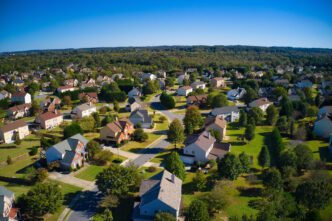In a detailed examination of housing affordability in the United States, recent data reveals that families across the nation are dedicating a substantial portion of their income to mortgage payments. According to the National Association of Home Builders (NAHB), a typical family earning the median income now spends 38% of their earnings on mortgage payments for a median-priced home.
The National Association of Home Builders (NAHB) and Wells Fargo have reported that the Cost of Housing Index (CHI) indicates a significant portion of family income is consumed by mortgage expenses. For families with a median income of $97,800, 38% is allocated towards mortgage payments for both new and existing homes alike. This figure remains unchanged from previous quarters, highlighting a persistent trend in housing costs.
Notably, families with lower income levels experience an even greater financial burden. Low-income families, defined as those earning only 50% of the median income, expend 75% of their earnings on similar mortgage payments. This marks a slight improvement from the previous quarter when the percentage stood at 77%, indicating a small but significant shift in affordability for these families.
The Cost of Housing Index further illustrates the challenges many American families face in the housing market. NAHB Chairman Carl Harris emphasized the widespread impact of the housing affordability crisis, commenting on the lack of housing units across numerous communities.
Another significant observation is that the affordability of existing homes has marginally increased between the second and third quarters of the year. While the proportion of family income required for a new home purchase remained consistent at 38%, there was a reduction from 79% to 75% for low-income families purchasing existing homes.
The national median price for new homes has risen to $420,400, from $412,300, while the price for existing homes has slightly decreased to $418,700. Concurrently, the average 30-year mortgage rate has dropped from 7.08% to 6.60%, potentially easing financial pressures for some homebuyers.
In terms of markets, the Cost of Housing Index reveals 10 metropolitan areas where families are severely cost-burdened, spending over 50% of their income on housing. The San Jose-Sunnyvale-Santa Clara area tops this list, with 85% of a family’s income directed towards housing costs. These areas also pose a severe financial strain on low-income families, who spend between 127% and 170% of their income to secure housing.
Conversely, several markets present less financial strain. Decatur, Illinois, ranks as the least cost-burdened market where only 16% of a family’s income is necessary to afford a mortgage. Within this group, low-income families manage with 33% to 39% income allocation for housing costs.
NAHB Chief Economist Robert Dietz pointed out the necessity for governmental action to eliminate construction barriers, facilitating the development of more affordable housing, crucial to addressing the shortfall of 1.5 million housing units.
The latest figures from the Cost of Housing Index underline the ongoing struggle for many families balancing household finances and mortgage obligations. As housing affordability challenges persist, targeted efforts at both the local and national levels are imperative to create a more sustainable housing market. Addressing these issues is crucial to ensuring that all American families can secure affordable housing and attain financial stability.
Source: FloridaRealtors








